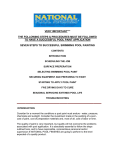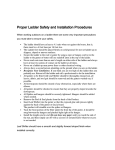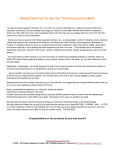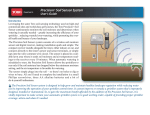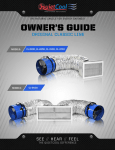Download Homeowner`s Tip Guide - Old Republic Home Protection
Transcript
OLD REPUBLIC Home Protection TABLE OF CONTENTS Monthly Maintenance Schedule .................................. 1 When you buy your car, you take it in Annual/Semi-Annual Maintenance Schedule ............. 1 for regular maintenance, oil changes Plumbing Emergencies ................................................. 2 and tune-ups. Unfortunately, homes Electrical Emergencies .................................................. 3 do not have a “service station” that Gas Leaks ....................................................................... 3 will take care of regular maintenance Fire Precautions ............................................................. 4 and upkeep. In most cases, your Roof Maintenance ........................................................ 4 home did not come with an Roof Inspection ............................................................. 4 “Owner’s Manual” to tell you what Home Exterior ............................................................... 6 needs to be done, when it needs to be done, and how to do it. Siding Inspection ........................................................... 6 Exterior Caulking .......................................................... 7 Old Republic Home Protection takes Foundations................................................................... 7 pride in being “People Helping Garage Doors ................................................................ 8 People”. We have compiled an Driveways, Walkways & Steps ...................................... 8 “Owner’s Manual” designed to help Wood Decks................................................................... 8 you with regular home-related topics Plumbing Fixtures/Faucets and Pipes ........................... 9 such as: Toilets............................................................................. 9 • How to develop an annual Septic Tank..................................................................... 9 maintenance schedule for many Water Heater................................................................. 9 of your home’s systems and Garbage Disposal .........................................................10 appliances. Dishwasher ...................................................................11 • Maintenance information which Electric Cooktop/Range/Oven......................................12 will help you avoid bigger Gas Cooktop/Range/Oven............................................12 problems by taking care of them Microwave Oven ..........................................................13 when they are small. Trash Compactor ..........................................................13 • How to “trouble shoot” malfunctions on your own, so you can resolve those Refrigerator & Freezer .................................................14 Clothes Washer.............................................................15 Clothes Dryer ................................................................15 malfunctions without the need Heating System.............................................................16 for a service person or the Air Conditioning System ..............................................16 expense of a home protection Electrical System ...........................................................17 plan service fee. Pool/Spa Equipment.....................................................17 Maintenance Schedule • Have evaporator coil inspected and cleaned, if necessary MONTHLY Safety • Have chimney(s) cleaned and inspected • Make sure your fire extinguishers are fully charged Electrical • Test your: • Replace the batteries in smoke detectors twice a year. An easy way to remember this is to change the batteries when the time changes. It's also a good idea to vacuum out the smoke detectors when you change the batteries so they stay clean and operate at peak efficiency – Garage door opener(s) – GFCI receptacles and breakers – Smoke detectors to ensure you have fresh batteries – Carbon monoxide detectors to ensure you have fresh batteries Exterior Plumbing • Clean and inspect gutters and downspouts after trees have seeded; repair as needed • Check plumbing fixtures and “water-using” appliances for leaks • Hose off house exterior; scrub off any mildew • Grind a cut-up lemon and then 2-3 cups of ice in the garbage disposal (the lemon keeps your disposal fresh and odor-free while the ice helps keep the blades sharp) • Clean gaps between deck boards, under decks and porches and treat for fungus and mildew as needed • Check paint, siding, or masonry for deterioration. Deteriorated paint can lead to widespread rot. One topcoat of paint should last four or five years, but two coats can last twice that long • Clean pop-up sink and tub strainers • Pour a mixture of baking soda, white vinegar, and boiling water down drains to keep them running freely • Inspect weather stripping around windows and doors; replace as needed • Pour water down seldom-used drains • Drain a few gallons of water from the valve at the base of the water heater to remove sediment and extend the life of the water heater • Inspect window screens; repair as needed • Clean out basement window wells • Clean sliding door tracks and lubricate with white lithium compound • Clean faucet aerators and shower heads with a soft brush to remove mineral build-up • Inspect basement/crawl space and attic for signs of pests such as termites, carpenter ants, wasps, and hornets Appliances • Clean refrigerator drain pan • Clean dishwasher food filters and check that openings in spray arms are clear; check dishwasher for leaks ANNUALLY OR SEMI-ANNUALLY • SUMMER Plumbing • Clean kitchen exhaust fan filters • Check the flapper on your toilets at least once a year. If it is an older one, you may want to replace it since it could allow water through, causing your toilet to “run” continuously Heating and Cooling • Check furnace or cooling filter, replace if necessary Heating and Cooling ANNUALLY OR SEMI-ANNUALLY • SPRING • Examine windows; re-glaze as needed Plumbing • Ensure all east, west and south facing windows are shaded to decrease cooling costs • Inspect septic field and tank area for flooding or odor • Have septic tank inspected and pumped as needed Garage Door • Inspect water heater temperature pressure relief valve for signs of leaks or discharge • Clean and lubricate garage door tracks, rollers, springs and hinges; tighten screws • Flush the water heater • Inspect paint and sealant on exterior and garage door, particularly along the bottom edge Heating and Cooling • Clean around air conditioner compressor Interior • Inspect walls and ceiling for cracks, sags, bowing or leaning • Have heat pump or air conditioning system cleaned and tuned-up before cooling season begins • Clean and seal tile grout Page 1 Maintenance Schedule • Inspect gutters and downspouts for leaks during a rainstorm ANNUALLY OR SEMI-ANNUALLY • FALL Plumbing • Keep gutters free from debris and ice • Close and drain hose bibs, drain and store hoses • On a windy day, feel around the edges of doors, windows and fireplaces for any air leaks. Look for dust piles as clues to leaks. Caulk and repair weather stripping as needed • Check septic field and tank area for flooding or odor • Inspect water heater temperature pressure relief valve for signs of leaks or discharge Heating and Cooling Emergencies • Clean around air conditioner condenser, then cover to protect during the fall/winter months OVERVIEW • Have fireplace and flues inspected and cleaned, repair as needed Despite your best precautions, emergencies can still occur. You can prevent an emergency from becoming a catastrophe by learning what to do. This section discusses how to react to: • Schedule heating system tune-up and cleaning • Clean ceiling fan blades • Plumbing emergencies Exterior • Electrical emergencies • Check paint, siding, or masonry for deterioration. • Gas leaks • Trim foundation plantings to leave a foot of clear space between plantings and house • A fire Read this section and discuss it with all members of your household, reviewing annually, so that everyone is prepared for an emergency. Make copies of these pages for your baby-sitters so they will be prepared if an emergency strikes while you are away. • Rake debris away from side of house and other structures • Clean gutters and downspouts; repair as needed • Check roof for leaks • Check exterior house siding The first step during an electrical problem, water leak or gas leak is to shut off the flow of electricity, water or gas to your home. Every member of your household should know how to find these shutoff valves and switches. • Trim any tree branches near or touching roof or gutters • Check all exterior caulk; repair as needed • Insulate for winter – On a windy day, feel around the edges of doors, windows and fireplaces for any air leaks. Look for dust piles as clues to leaks. Caulk and repair weather stripping as needed You should keep a basic emergency kit that includes: • A battery powered transistor radio • Clear storm window weep holes of debris • A flashlight • Clean under decks and porches as well as the space between the deck boards • Extra batteries • Clean out basement window wells • A first-aid kit • Candles and matches • A first-aid manual ANNUALLY OR SEMI-ANNUALLY • WINTER These supplies will be welcomed if a natural disaster occurs. In addition, the first-aid kit and first-aid manual are good to have on hand for household use. Plumbing • Clean and seal grout • Exercise (turn off and on) plumbing shutoff valves and inspect for leaks • Inspect water heater temperature pressure relief valve for signs of leaks or discharge PLUMBING EMERGENCIES Main Water Shutoff Valve Main water shutoff valves are frequently located near water meters. Your water meter is likely outside near the street. Main water shutoff valves can also be located inside your home beneath a floor access panel or in a basement. Floor access panels are commonly found in closet floors. Look for a large valve in the middle of a pipe. Electrical • Ensure your supply of flashlights has fresh batteries in case of a winter storm power outage Exterior • Inspect roof after large winter storms Page 2 Emergencies are in doubt about the safety of frozen food after a power outage, throw it out. ELECTRICAL EMERGENCIES Electrical emergencies such as an appliance malfunction, a power failure in your home or a neighborhood power outage can occur at any time. Sparking Appliance Do not touch a smoking or sparking appliance. Instead, cut off power to the appliance by unplugging the appliance, turning off the wall switch controlling the appliance or turning off the circuit breaker for the appliance. Allow the appliance to cool, then take it to a repair shop or call a professional service representative to repair the appliance. You should know how to turn off the electrical power to your home and turn off and reset individual circuit breakers. Main Disconnect The main electrical disconnect should be located in or near the circuit panel box. The circuit panel box is usually in the garage, utility room, or utility closet . If the appliance catches fire, get everyone out of the house, meet at your designated area and call the fire department from a neighbor’s home. Turn off the electrical power to your house by shutting off the main disconnect. The main disconnect is one or more main fuses or circuit breakers located on the circuit panel. Do not use water on an electrical fire, it can be fatal. If you discover an electrical fire early, use a multipurpose fire extinguisher on the flames. If the circuit panel is located in a laundry room or some other place where there could be water on the floor, use rubber gloves when shutting off the main disconnect. Keep a pair of rubber gloves near the circuit panel at all times for this purpose. If an appliance’s electrical plug smokes or sparks, unplug the appliance by pulling its cord. Do not touch the plug itself. After the plug cools, inspect the plug and cord for damage. If they are damaged, replace the plug and cord or have them replaced by a professional service representative. Reset any tripped circuit breakers. Be sure everyone in your household knows where the circuit breaker panel is located and can shut off the power. Power Outage If the plug and cord appear to be OK and there are no tripped circuit breakers, the electrical outlet may be at fault. Test the outlet by plugging another appliance you know works properly into the receptacle. If that plug sparks too, replace the outlet or have it replaced by a professional electrician. If the new appliance does not cause sparks, then the original appliance is probably faulty and should be repaired or replaced. If the power goes out suddenly in your home, determine whether the outage affects just your home or the entire neighborhood. If it is a neighborhood outage, notify your electric utility company. If the electrical outage affects your home only, check for and reset tripped circuit breakers. If a breaker immediately trips again, call a professional electrician to test your electrical system. Turn off or disconnect all motor-driven and electronic appliances to avoid possible damage from either inadequate power or a sudden electrical surge when power is restored. The furnace blower motor can be turned off by turning off the circuit breaker for the furnace. GAS LEAKS Motors for dishwashers, clothes washers, clothes dryers, garbage disposals, range fans, sump pumps, refrigerators and other appliances can be disconnected by turning off or unplugging the appliance. Computers, televisions, video recorders, stereos and other electronic equipment should also be turned off. Turn on a radio and a lamp to alert you when service is restored. Your home may be serviced with natural or bottled gas. Gas is a safe, clean, economical energy source for appliances such as furnaces, boilers, water heaters, dryers, cooktops, fireplaces and barbecues. Although gas appliances are wonderful conveniences, gas must be treated with respect. If you smell gas inside or outside your home, hear gas escaping from a broken line or see a broken gas line, you should: • Get everyone out of and away from your home immediately After power has been restored, it should be safe to turn on all appliances. You can retard food spoilage by not opening refrigerators or freezers during the outage unless absolutely necessary. Food in a tightly packed freezer will stay frozen for up to 48 hours if the door has been kept closed. Food in a partially filled freezer may keep for 24 hours. If you Page 3 • Call your local gas company or your fire department from a neighbor’s house • Do not light a match, turn a light on or off, use a telephone (portable, cellular or regular) or operate any electrical switch or electronic device – flames or electric sparks can ignite the leaking gas • Leave as many windows and doors open as Emergencies – Turn off the kitchen exhaust fan. The fan can suck fire through the fan and ignite the outside of your home. possible – the gas will rise and dissipate harmlessly outside If the gas leak is inside your home, you can turn off your gas supply at the gas shutoff valve after everyone is out of the house. If you prefer, you can have your utility company turn off the gas. • Oven fire – Turn off the oven and allow the fire to burn itself out. The gas shutoff valve should be located on the pipe leading into the gas meter. Turn the valve a quarterturn in either direction with an adjustable-end or “crescent” wrench. The gas is off when the valve is perpendicular to the pipe. If the gas leak is outside your home, keep away from the leak area and away from your house. Do not attempt to shut off the gas supply. Your utility company will turn off the gas. – Do not open the oven door - fresh air will feed the fire and cause it to continue to burn. • Electrical fire – If you discover an electrical fire early, use a multipurpose fire extinguisher. – Do not use water on an electrical fire. Water and electricity can be fatal. Fire Extinguisher Once your gas is off, wait for the local gas company to restore your service. Cooking is a leading cause of fire. If a fire breaks out in the kitchen, you will want an extinguisher close at hand. If there is a fire in another part of the home, you will know that an extinguisher can be found in the kitchen. FIRE PRECAUTIONS Precautions and plans made today can prevent a fire-related tragedy tomorrow. Read the operating instructions on the side of the extinguisher now so that you will know how to use it if needed. Finally, have the extinguisher serviced at the time recommended by the manufacturer. The manufacturer’s service recommendations should be printed on the side of your fire extinguisher. Smoke detectors are your first line of defense if a fire breaks out at night. Test your detectors on the first day of each month. Replace the batteries in the spring and fall when you change your clocks. “Plan of Escape” The first step during a fire is to get everyone out of the house. Planning your escape routes now can prevent needless loss of life during a fire. ROOF MAINTENANCE It’s easy to ignore your roof unless it begins to leak, demanding immediate attention. If you inspect your roof periodically, you can correct minor problems before they cause major damage. 1. With your family, map out escape routes from each room in your home. Pay particular attention to escape routes from bedrooms. Do not go up on your roof unless you: 2. Agree on a central area outside your house to meet after evacuation so that everyone can be accounted for. This may be a neighbor’s front door or a neighborhood landmark. The meeting place should be a place that children or injured people can reach without undue difficulty and yet still be safe from danger. • Feel comfortable working from heights • Know how to safely use an extension ladder • Have the necessary tools and equipment If you have a tile or slate roof, do not go on your roof for any reason. These types of roof shingles can be easily broken from your body weight. 3. Have safety ladders near windows when ladders are necessary. Many roofing materials come with manufacturer’s warranties. However, in order to make a claim on a warranty, you may need to know: 4. Keep stairs, doorways and hallways free from obstructions. In dense smoke, it may be difficult to see items blocking an escape route. • The manufacturer’s name • The place purchased In the Event of a Small ”Contained“ Fire If you discover a small fire that is still contained to its source, you can do the following: • Cooking pan fire • The installer’s name ROOF INSPECTION You should inspect your roof: – Cover a small oil or grease fire in a cooking pan with a lid to smother the flames and remove the pan from heat. • Each fall before the winter weather begins • After heavy wind or snow storms – to inspect for damage – Do not use water on an oil or grease fire. Water will spread the flames. • In the spring to look for winter damage Page 4 Exterior Maintenance If you discover any problems, call a roofing professional. 8. Inspect gutter seams, corner joints and downspout joints for proper fit. These joints should be repaired or sealed with caulk if they allow water to leak. Inspecting from the Inside: 1. Begin your roof inspection in the attic. Examine the main roof ridge, rafters and sheathing for moisture. Look for: 9. Inspect downspouts. Check for: a. Disconnected downspouts b. Corrosion a. Water stains c. Clogged sections b. Dark-colored areas of wet wood d. Improper connections c. Soft spots that may indicate dry rot e. Loose straps 2. Use a strong flashlight to inspect visually, then use a knife or thin screwdriver to probe for dry rot. f. Missing sections 10. Make sure the downspouts direct water away from your home. 3. Mark any problem areas with chalk so you can find the areas later. Inspecting from the Outside (sloped or pitched roofs) 4. If it is necessary to remove fiberglass insulation to examine the sheathing wear loose clothing, gloves, goggles and a respirator for protection. 1. Step away from your home until you are able to see all exposed sections of your roof. 5. Turn off the lights and look for light coming through the roof. This is a sign of holes, cracks or other problems. Small shafts of light coming in at an angle indicate cracks that may swell shut when shingles are wet. 2. Use binoculars to visually inspect all portions of your roof. Binoculars allow you to get a close-up view of your roof without climbing up and moving around on a sloped surface. 3. Check the roof structure first by looking at the lines of the ridge and rafters. 6. If you see any holes above you, drive nails or poke wire through the holes so they will be visible from the roof’s surface. a. The ridge line should be perfectly horizontal b. Inspect the line of the rafters by looking along the plane of each roof section. The plane should be straight Inspecting from the Outside (all roof types) 1. Inspect the flashing in the following areas: a. Roof valleys c. If either the ridge line or the plane of a roof section sags, call a professional contractor. You may have a structural problem b. Roof and plumbing vents c. Around chimneys 4. Inspect the roof’s surface. Look for the signs of wear and damage. d. Along eaves e. Anywhere water can seep through open joints into the roof sheathing Inspecting from the Outside (flat roofs) 1. Flat roofs are not visible from the ground. If you have a flat roof, you must inspect it from the roof itself. 2 Look for any flashing that has buckled or pulled away from the joints it is supposed to protect. 3. Look for holes and rust spots along the flashing surface. a. Small holes and rust patches can be patched or sealed a. If your roof is higher than a single story, look for a way to access the roof from a door, window, access panel or other interior access b. If the roof is higher than one story and does not have interior access, then it is best to have the roof inspected by a professional roofing contractor b. Replace the flashing if you find large holes or extensive corrosion 4. Examine the flashing seams for dried or cracked roofing cement. Re-seal as necessary. 5. Look for loose nails and exposed nail heads. They should be re-nailed and covered with caulk or roofing cement. 6. Check gutters for any loose spikes or support straps and repair as necessary. 2. Look for puddles of water. Although some people used to believe standing water on a flat roof would help keep the home cool during the summer, the disadvantages far outweigh any cooling benefits. a. Insects, plants and fungi can breed and grow in the water 7. Gutters should slope gently towards the downspouts. Reset gutters that sag or slope improperly. b. Roots from growing plants can puncture your roofing material Page 5 Exterior Maintenance HOME EXTERIOR c. During the winter, freezing water can cause serious roof damage Your home is protected from the sun, wind, and rain by an exterior skin of wooden, masonry or manufactured siding. This siding should last the life of your home if properly maintained. However, even the most durable sidings can fail if the homeowner does not follow through with a regular maintenance program. d. If you see standing water or signs of past water puddles, discuss this matter with a professional roofing contractor 3. Your flat roof should drain along the roof edges and into downspouts or through drains located in the roof itself. Exterior Cleaning 4. If your roof has one or more interior drains, inspect the drains to make sure they flow freely and are not clogged with debris. Cleaning your home’s exterior surfaces once or twice a year will improve it’s appearance and will help preserve your paint, stain or siding finish. Roof Flashing Wash from the bottom up with a solution of soap and warm water. Washing from the bottom up prevents streaking. Pay particular attention to the areas around door handles and window catches where dirt and grease will be heaviest. Rinse with fresh water from top to bottom to prevent runs of dirty liquid on a newly cleaned surface. You can use a pressure washer or a garden hose and scrub brush for this job. Flashing is the sheet metal or other durable material that protects roof joints and other protrusions from water penetration. You will find flashing in the following locations: • Roof valleys • Roof and plumbing vents • Around chimneys If you find mildew on your siding, apply a household bleach solution directly to any affected areas and rinse with a garden hose. • Along eaves • Anywhere else water can seep through open joints into the roof sheathing SIDING INSPECTION The flashing’s edges are sometimes sealed with caulk or roof cement. Flashing is key to keeping your roof watertight. You can avoid repair to and replacement of your entire roof when you stop a leak by re-caulking a dried out flashing seam. Paint 1. Protect your siding by inspecting for paint problems twice a year and repainting every two to five years, or as necessary. 2. Peeling or blistering paint is usually caused by warm, moist vapor from the house flowing through the walls, reaching the cold sheathing and condensing. Gutters and Downspouts Gutters and downspouts collect water from the roof and carry it away from the house. This prevents: • Topsoil erosion around concrete footings a. Just a few drops of water between the siding and the film of paint will cause paint to blister and peel • Basement flooding • Siding and woodwork decay b. It may be necessary to install vents in the siding to remedy the moisture problem • Paint damage • Wall damage c. The defective areas should be properly prepared and repainted • Serious foundation problems Gutters and downspouts that leak or that are clogged with debris cannot perform their vital task. Gutters collect leaves, sticks, seed pods, mineral granules from roofing products and other debris. They should be cleaned: 3. If you observe other paint problems, such as worn, flaking, wrinkling or “alligatoring” paint, properly prepare and repaint the affected area. Ground Clearance 1. Untreated wood must not be in contact with the ground. Moisture from the soil can cause decay as well as allow insects to gain entry to your siding. • In the fall after most of the leaves have fallen • In the spring after the trees have bloomed If you have low gutters and know how to safely use extension ladders, you may feel comfortable performing this task yourself. If you have a multistory home, don’t like working from heights or don’t like handling extension ladders, you may want to hire a contractor to clean your gutters. Page 6 2. Examine along the base of your home to make sure you have at least 6-8 inches of clearance between the ground and any wood siding or wood trim. 3. If necessary, re-grade your soil away from any wood. Exterior Maintenance Stain FOUNDATIONS Your foundation supports your home and keeps it from shifting. You should inspect your foundation twice a year to ensure it lasts for the life of your home. 1. Stain protects wood siding from moisture and insects. 2. Re-stain your siding every five to seven years, or as necessary, to restore color and preserve your siding. The type of foundation you have depends on your home's design and your particular soil conditions. In areas where flooding or weak soil is a problem, houses are often built on piers or pilings. In some areas, pressure-treated wood foundations have become popular. The most common foundation, however, is a concrete or masonry perimeter enclosing a crawl space, full cellar or basement. Dry Rot and Termite Damage Dry rot is a fungus that causes wood to crumble and termites destroy wood by chewing its interior. 1. Probe the edges of the wood siding with a knife or thin screw driver and look for soft, spongy spots. Pay particular attention to any part of the siding that was close to or in contact with the ground. Foundation Inspection Cracks: 1. Begin your inspection by looking for cracks along the foundation’s outside wall. a. Normal curing of concrete and mortar joints can cause cracks. Most cracks are normal and are structurally insignificant b. Cracks wider than 1/16 inch should be investigated, possibly with the assistance of an engineer or qualified inspector, to determine whether the cracks are a cause for concern 2. Check the slope of the ground around your foundation a. The ground should slope away from your home so rain water will flow away from, not toward the foundation. b. Back filled soil along the house can settle over time. This can create a depression that will collect water near the foundation. Correct any depressions by raising the grade with topsoil (not sand or gravel) so that the ground slopes 2 inches per horizontal foot for 8 to 10 feet from the foundation 2. Check for visible evidence of termites. Look for their translucent one-half-inch-long wings or the mud tubes they sometimes build. If you find evidence of dry rot or termites, consult a licensed termite or pest control professional. Holes and Split, Warped or Loose Siding Simple surface problems such as holes in the wood, split or cracked boards, warped or buckled boards and loose siding should be repaired as soon as they appear. Water will work its way through these defects into the interior wall where rotting can take place undetected. Find the source by checking for deteriorating roofing, leaking gutters or downspouts and poor drainage. EXTERIOR CAULKING Caulking is used to seal joints, gaps and seams in exterior walls. Without caulking, cool air, water and insects could enter your home through these openings. Typically, your home should be re-caulked every five years or less. Where to Inspect Roof: 3. Settling along the foundation can also cause concrete patios and walkways to break and direct water towards your home. A contractor can add a new layer of concrete to reverse the slope. Moisture • Where one flashing meets another flashing You should watch for: • Where the flashing and a roof or dormer surface meet • Condensation • Basement leaks • Where a chimney, flue, plumbing or electrical pipe, attic fan or skylight protrudes through the roof surface • Crawl space moisture These problems can cause wood structural members to decay. Exterior Walls: Condensation • Where siding and trim meet at corners • Where siding meets the foundation, patio, deck or any other part of your home • Around window and door frames • Between poorly fitted pieces of siding • Where pipes, framing members and other materials protrude through siding Page 7 1. Condensation is caused when warm, moist air comes in contact with a colder surface such as a window, exposed pipe or bare concrete basement wall. It can look as if the window, pipe or wall is leaking. Condensation can be worse in new homes as water from concrete walls evaporate as part of the normal curing process. Exterior Maintenance an automatic return switch so that the doors will reverse automatically if they meet an obstacle. 2. Proper ventilation can control condensation. Crawl Space Moisture 1. Test your garage door openers by blocking the door with your hands while the door is closing. If the door does not reverse when it encounters your hands, adjust the automatic reverse adjustment screws. Soil under a crawl space can cause beams, floor joist, sub-floors and even roof sheathing to decay. Inspect all crawl spaces with a flashlight. 1. If it is necessary to go into the crawl space to view the entire area, wear a face mask. You can stir up insecticides and other chemicals that settled on the ground. 2. Height adjustment nuts control how far the doors open and close. If your doors do not open or close properly, you can reset the adjustment nuts. 2. Look for a moisture barrier. 3. If the drive unit works but the door won’t open, the belt connecting the pulley with the motor may need adjusting. a. All bare soil should be covered with a moisture barrier of 6-mil polyethylene plastic b. The plastic should go up the foundation walls to a point higher than the outside grade line and be weighted down with bricks, gravel or other non-organic material DRIVEWAYS, WALKWAYS & STEPS Concrete driveways, walkways and steps usually have expansion joints to minimize cracking. However, cracking is a natural characteristic of concrete that cannot be eliminated and should not create serious problems. 3. Look for standing water. There should never be standing water under your home. If there is, consult a professional contractor for drainage options Snow and ice can damage concrete driveways, walkways and steps. Remove snow and ice promptly to protect your concrete. If you cannot remove a thin layer of ice, sprinkle sand or cat litter on the ice for traction. Do not use salt or chemicals to melt the ice. Salt and chemicals can damage your concrete and kill nearby grass, trees and shrubs. 4. Inspect the foundation vents. a. Foundation vents help control moisture in the crawl space b. Make sure the vents are open and not blocked by soil, leaves or other debris c. If the crawl space smells musty, you need more ventilation WOOD DECKS GARAGE DOORS You can prevent many garage door problems with regular maintenance: Cedar or redwood boards, treated wood and stained or painted wood are common materials for wood decks. Cedar and redwood are more expensive than other decking materials but do not need to be painted or pressure treated. As the cedar weathers, it will turn a distinctive driftwood gray color. Redwood darkens to a natural color as it weathers. 1. Periodically clean the tracks, hinges and rollers. 2. Lubricate the tracks, hinges and rollers with penetrating oil or silicone spray. 3. Lubricate the locks with graphite powder. 4. Tighten the garage door screws every 12 months. They fasten the hardware to the door and will loosen over time as the door settles or as wood doors shrink. 5. Inspect the springs regularly. Replace any springs that develop bulges or are unevenly spaced. 6. Inspect the tracks for proper alignment, crimps in the track and other damage. If the door binds or drags, it is likely the tracks are poorly aligned or need lubrication. 7. Keep wood doors sealed and painted, particularly along the bottom edge, to prevent swelling and moisture damage. Garage Door Opener An improperly adjusted garage door opener can cause a serious accident. Your openers should have Page 8 Your wood decking will expand and contract with changes in the weather. This will cause nails to pull away from the boards and could cause some boards to warp. 1. Reset any pulled nails and re-nail any warped boards with a finishing hammer. 2. Do not use a regular hammer. The head of a regular carpenter’s hammer will dent the wood around the nail. There should be gaps between the deck boards so that water can drain from the deck. These gaps, however, can collect dirt, leaves and other debris. The obstructions can then soak up water and cause the wood to decay. Places where deck boards rest on joists underneath the deck are particularly prone to collecting obstructions. Your deck will last longer if you clean between the deck boards with a pressure washer once a year. Page 9 Page 10 Page 11 Page 12 Page 13 Page 14 Page 15 Page 16 Page 17





















